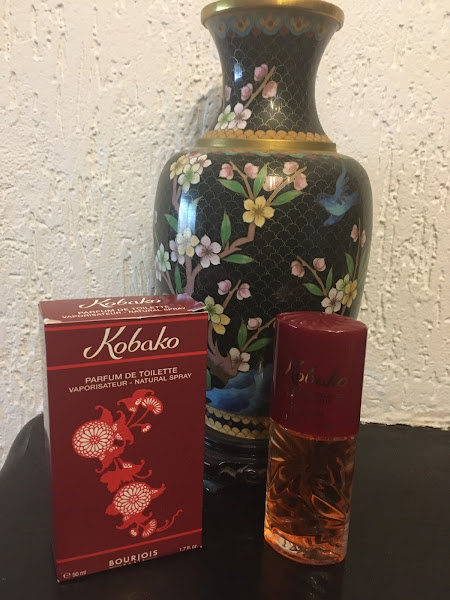Kobako means "small box" in Japanese, as far as I know. But try adding a katana-blade symbol over the first "o," and it turns into Kōbako. Then it gains the nuance of a small box for solid aromatics used in the incense ceremony in kōdō (香道, "Way of Incense"); the ritual burning of incense to count the time. Such is the case with Kobako by the classic French brand Bourjois.
A composition that initially hails from 1936 and the creative genius of perfumer Ernest Beaux, but which survives to this day in a contemporary Parfum de Toilette version that was first issued during the 1980s in the cristal taillé style bottle and the maroon box photographed below. The actual launch date for the modern version is 1982, and I doubt that the two editions have much in common, both stylistically and artistically. There was too much water under the bridge by then.
photo by Elena Vosnaki
It's interesting to note that one of the connotations for the word 'box' is the one used in slang, in many languages, for female genitalia. Indeed, again as far as I have been informed, kōbako in modern Japanese slang refers to that as well. But the scent in question is not an animalic or intimate smell that would polarize at all. In fact, it's this discrepancy that prompted my review.
The current fomula is not the one from the 1930s, so the description pertains to the 1980s mix.
The domineering feeling is one of soap, like an old-fashioned soap for men, with cinnamon and sandalwood, and that creamy feeling that generations past associate with comfort and hot water. The florals used in the heart of Kobako are not discernible; they mix and mingle and tear apart again. There is definitely rose, which mollifies the formula, and probably a segment of something white-floral for a bit of clarity (possibly a part of lily of the valley aroma chemicals to give diffusion and expansion.)
Kobako combines these elements in a naughty, playful, almost haphazard way - the masculine backdrop with the feminine florals and the aldehydes - to render a juxtaposing composition. It hides its dark corners, but it's not entirely clean either. It has the versatility to make itself wearable all year long and never bother or disappear.
It feels fresh and spicy one minute, metallic and powdery the next, with a segment of dry patchouli in the back. What is this scent, I ask you? It consistently garners some comment or other, always in a positive way. It might not be the most accepted fragrance or the most derided - it hinges on that razor-sharp axis - but it's worth sampling at the very least. Some of you will end up wearing it when you won't know what to wear for the day, I promise.
The woody element in the back and the soapiness render Bourjois' Kobako very easy on the skin. There is not enough spice, although cinnamon is mentioned. I do not detect it as such, more of a smidge of clove, which is faint. It's also quite musky, in a good way, not the screechy white musk from laundry detergents, but not dirty either. It just melds with the skin and holds on to it.
.jpg)

This perfume is so rich and warm.
ReplyDeleteIn a Greek site about perfumes I saw many nembers having it in their wardrobes.
So, I bought it and it is close to Red by Georgio Beverly Hills which I love and not so close to the vintage Opium by Saint Laurent that I don't like it very much.
Thank you for the article!